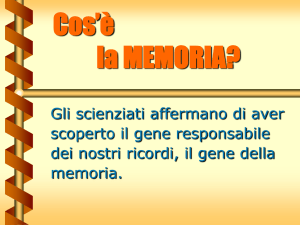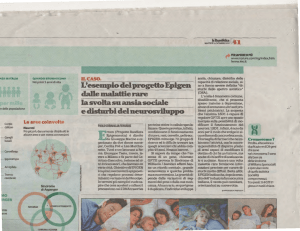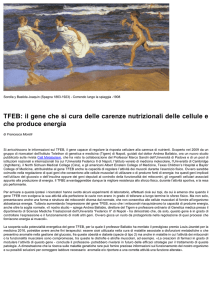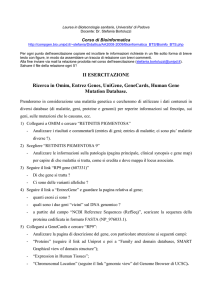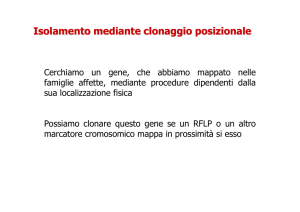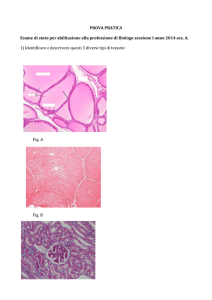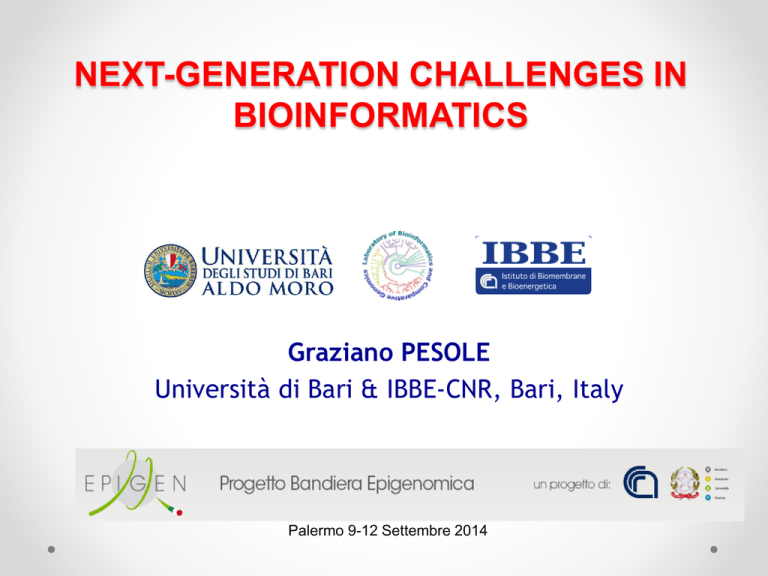
NEXT-GENERATION CHALLENGES IN
BIOINFORMATICS
Graziano PESOLE
Università di Bari & IBBE-CNR, Bari, Italy
Palermo 9-12 Settembre 2014
The birth of Bioinformatics
PCR
Roche 454
1985
2004
1953
1977
1986
1995
DNA structure
Maxam & Gilbert AB Sequencer First genome of a
free-living organism
Sanger
sequencing methods
2001 Human Genome
2
Maxam & Gilbert Sequencing
G A+G T+C C
Base-specific modifications
G
A+G
T+C
C
DMS pH 8
pH 2
Hydrazine
Hydrazyne NaCl 1.5 M
Cut by piperidine
The DNA fragments which differ by one
nucleotide are denatured by heat and separated
by gel electrophoresis in the presence of 8M
urea, a denaturing agent that prevents the
formation of intra-chain pairings.
The residues of A are identified by comparing the
positions G-only cuts with those of A+G-cuts, and
analogously T residues are identified by
comparing the positions C-only cuts with those of
T+C-cuts.
Sequencing data explosion
Sequencing data growth and costs:
Big Data in Biology
Worldwide distribution of NGS platforms
>2558 total machines (>1000 US, >300 China, .., >50 Italy)
Source: omicsmap.com
Challenges
1
Technology (Storage, Retrieval,
Computation, Networking)
2
Science (Data integration, Analysis,
Statistical evaluation)
Technology challenges
Technology challenges
NGS data
Reference
databases
Moving tools instead than data may be faster
and more effective.
Experimental challenges
Experimental challenges
1
Experimental data analysis
State of the art methods for data analysis are still not fully satisfactory
and different methodologies generally produce only partially overlapping
results (e.g. RNA-Seq data analysis for mRNA isoform detection and
quantification, characterization of the methylation pattern by BS-Seq,
etc.).
Experimental challenges
2
Data and results integration
A relevant breakthrough in understanding molecular mechanisms can be
obtained integrating data form different sources (e.g. correlating
epigenetic marks and expression profiles, etc.). A few tools are so far
available and therefore efforts in this direction are highly needed.
Experimental challenges
3
Model design and validation
The ensemble of data and their specific inter-correlations should make
possible the design of specific models that should be reliably validated.
Some efforts in this direction are in progress (e.g. virtual cell models,
http://www.nrcam.uchc.edu/) but they are generally nice exercises
without relevant “practical” outcomes.
This is the real new frontier of modern biology.
Dimensioni dei Genomi Eucariotici
plasmids
viruses
bacteria
fungi
plants
algae
insects
mollusks
bony fish
amphibians
Il Genoma umano è costituito da
circa 3 miliardi di bp e contiene un
numero di geni (ancora imprecisato)
pari a circa 25,000.
104
105
106
107
reptiles
birds
mammals
108
109
1010
1011
Assenza di correlazione tra numero di geni e
dimensione del genoma negli eucarioti
Gene number
Genome size (Mb)
100000
10000
Number of genes in prokaryotes (up to 8000)
1000
100
10
Genome size in prokaryotes (up to 9 Mb)
1
human
mouse
chicken
xenopus
zebrafish
fugu
ciona
fly
worm
yeast
15
Assenza di correlazione tra numero di geni e
complessità organismica
20.000 geni
103 cellule
20.000 geni
1013 cellule
16
La porzione non codificante dei genomi eucariotici
coding
100
90
80
70
60
50
40
30
20
10
0
non coding
E.coli
S.cerevisiae
C.elegans
Human
4.7 Mb
12.1 Mb
100 Mb
3000 Mb
L’annotazione funzionale delle porzioni non-codificanti
genoma è una delle sfide principali dell’era post-genomica.
del
17
Genoma nucleare umano
(Nature, 431: 931-945, 2005)
(da: Molecular Biololgy of the Cell, Fig. 4.17)
La porzione codificante rappresenta l’1-2% del genoma (geni codificanti per
proteine, tRNA e rRNA.
La porzione non-codificante è costituita da sequenze uniche e sequenze
ripetute. Queste si suddividono in: 1) ripetizioni intersperse LINEs, SINEs, LTR,
trasposoni a DNA); e 2) ripetizioni in tandem (blocchi ripetuti in tandem dei
centromeri e dei telomeri, micro- e mini-microsatelliti, duplicazioni segmentali).
La distribuzione degli elementi ripetuti varia trai i cromosomi, con alcuni cromosomi
che contengono anche il 90% di DNA non codificante
18
Che cosa è un GENE
L’avvento dell’era genomica ha messo in crisi la tradizionale definizione di GENE,
tuttora molto dibattuta.
Lewin B. Il Gene VIII
Segmento di DNA coinvolto nella produzione di una catena polipeptidica,
comprende regioni (leader e coda) che precedono e seguono la regione
codificante, oltre alle sequenze intercalate (introni) tra i singoli elementi codificanti
(esoni).
Brown T.A. Genomi 2
Un segmento di DNA contenente informazioni biologiche, che codifica per una
molecola di RNA e/o proteina.
Ambedue queste definizioni non possono essere considerate corrette alla luce delle
attuali conoscenze.
Ovviamente, se non ci si accorda sulla definizione di gene, non è possibile
determinarne il numero, anche assumendo di disporre della annotazione completa
del genoma.
19
Definizione di GENE
Per giungere ad una definizione il più possibile corretta di GENE è necessario
conoscerne le caratteristiche principali.
• Un gene può utilizzare diversi promotori
• La trascrizione di un gene si può arrestare in corrispondenza di diversi terminatori
• I trascritti espressi da un gene possono subire splicing alternativo che generano
trascritti che differiscono sia nelle regioni non tradotte (5’ e 3’UTR) che nella
regione codificante
Il gene per tp73L codifica per 10 trascritti alternativi, e utilizza 2 promotori e 3 diversi
terminatori della trascrizione (predizione ottenuta dal programma ASPIC).
20
P1
P2
TAp63
(A)
(B)
1
2
3
10’
∆Np63
3’
4
5
6
Human TAp63
7
8
9
10
β
γ
11
12
13
14
α
_003722; 14 exons; 680 aa
Mouse TAp63
_001127259; 14 exons; 680 aa
Human TAp63
_001114978; 13 exons; 555 aa
Mouse TAp63
_001127260; 13 exons; 555 aa
Human TAp63
_001114979; 11 exons; 487 aa
Mouse TAp63
_001127261; 11 exons; 483 aa
Human Np63
_001114980; 12 exons; 586 aa
Mouse Np63
_011641;
Human Np63
_001114981; 11 exons; 461 aa
Mouse Np63
_001127262; 11 exons; 461 aa
Human Np63
_001114982; 9 exons; 393 aa
Mouse Np63
_001127263; 9 exons; 393 aa
12 exons; 586 aa
21
I geni possono essere sovrapposti
I geni possono essere sovrapposti tra loro, nello stesso orientamento o in
orientamento opposto, o anche essere completamente contenuti in altri geni.
L’introne 26 del gene neurofibromatosis type I (NF1) contiene 3 geni diversi
nell’orientamento opposto (OMGP, EVI2A, EVI2B).
vedi: http://posnania.biotec.psu.edu/research/overlapping_genes.html
22
Uno stesso gene può esprimere proteine con funzioni opposte:
l’esempio dell’attività della Caspasi 9 (CASP9)
La forma costitutiva della proteina (CASP9, 9 esoni, 416 aa) induce apoptosi. Essa contiene
un Caspase recruitment domain (CARD) e un dominio caspasi Peptidase_C14.
L’isoforma più corta della proteina (CASP9S, 5 esoni, 266 aa) contiene un dominio Caspase
recruitment domain (CARD) e un dominio tronco della Peptidase_C14. Questa isoforma è
priva dell’attività proteasica e agisce da inibitore dell’apoptosi.
Uno stesso gene può codificare per proteine indirizzate a diversi
compartimenti cellulari: l’esempio del gene NFS1
La proteina codificata dal gene NFS1 fornisce zolfo inorganico ai cluster ferro-zolfo rimuovendo lo
zolfo dalla cisteina, e formando alanina nel processo. Questo gene utilizza siti di inizio alternativi della
traduzione per generare una isoforma mitocondriale ed una isoforma citoplasmatica. La selezione del
sito di inizio della traduzione è regolata dal pH citosolico.
L’isoforma che codifica per la proteina mitocondriale (457 aa) contiene un peptide segnale e un dominio
aminotrasnferasico.
L’altra isoforma, che deriva sa un sito di inizio alternativo della trascrizione codifica per una proteina
più corta (397 aa) priva del peptide segnale ma contenente il dominio aminotransferasico.
Uno stesso gene può codificare trascritti soggetti ad un diverso meccanismo di
regolazione post-trascrizionale: l’esempio di SLC11A2 expression
Il gene SLC11A2 (divalent cation transporter) codifica per (almeno) due diverse isoforme, solo una delle
quali risponde alla concentrazione del ferro (i.e. i livelli della proteina aumentano sensibilmente in
seguito alla carenza di ferro). Responsabile del mecanismo di regolazione è un “Iron Responsive
Element (IRE)” nella regione 3’UTR presente solo in una delle due isoforme.
IRE
Nell’uomo il trascritto contenente l’IRE (16 exons) codifica per una proteina di 561 aa (NM_000617). Il
trascritto privo di IRE (17 exons) non è presente nella banca RefSeq e codifica per una proteina di 568 aa.
IRE
La stessa situazione si verifica nel topo, per cui l’unica entry RefSeq corripsonde alla
isoforma priva di IRE (NM_008732). Il meccanismo di risposta al ferro appare specifico del
tipo cellulare.
Definizione di GENE
Nuova definizione:
Una specifica regione di DNA, la cui trascrizione è regolata da uno o più promotori
e altri elementi di controllo trascrizionale che contiene l’informazione per la sintesi
di proteine e RNA non codificanti funzionali, tra loro correlati per la condivisione di
informazione genetica (con un tratto di sequenza genomica in comune) a livello dei
prodotti finali (proteine o ncRNA).
In questo modo è possibile associare al gene specifiche coordinate genomiche
che coincidono con il sito di inizio della trascrizione più a monte e il sito di
terminazione più a valle.
Gene
26
Una nuova definizione operativa di gene
A
A
A
C
B
DNA
C
C
Due trascritti, un gene: i prodotti funzionali finali si sovrappongono a livello
genomico. I due trascritti sono “geneticamente correlati” in quanto una mutazione
nella regione di sovrapposizione avrebbe effetti su entrambi.
Al fine di valutare se due trascritti sono geneticamente correlati è necessario
conoscere la localizzazione della regione codificante. In alternativa, questa
può essere predetta attraverso una serie di approcci bioinformatici.
Una nuova definizione operativa di gene
DNA
A
B
C
H
Due trascritti, due geni: i prodotti funzionali finali non si sovrappongono a livello
genico, mentre si osserva sovrapposizione a livello delle regioni 5’UTR. I due
trascritti non sono “geneticamente correlati” in quanto nessuna mutazione può
avere effetto su entrambi i prodotti finali. Una mutazione localizzata nella regione
5’UTR può modulare il livello di espressione di un gene, esattamente come una
mutazione a livello di un promotore o di una regione enhancer.
See: Denoeud et al., Prominent use of distal 5' transcription start sites and discovery of a large number of
additional exons in ENCODE regions, GENOME RESEARCH (2007)
.. “ Our results also suggest that genes are using the promoter(s) of other neighboring genes in specific cells
and developmental stages, … Consistently, we observe that 6.2% (46/738) of the new 5’ends .. are shared
by several genes, a proportion very likely to be underestimated..”
10-fold expansion of human transcriptome
and proteome
AspicDB v1.1
Genes
% Alternatively spliced genes
Transcripts
Proteins
% in frame Proteins
Independent splicing events
U2 introns (≥2 ESTs)
U12 introns (≥2 ESTs)
Other introns (≥2 ESTs)
18,439
91.2
223,435
172,544
89.5
181,591
289,953 (227,113)
1,775 (911)
51,567 (9,343)
We estimated that each gene - on average - generates about 12 different transcripts and 9
different proteins (90% in frame with the RefSeq protein). This implies “one order of
magnitude expansion” of the human transcriptome and proteome (20,000 - 25,000 genes
250,000 proteins). Furthermore, our estimate may likely be an “underestimate” of the
whole transcriptome/proteome complexity.
These data have been confirmed by Pan et al. (2008) and Wang et al. (2008) through a
deep RNAseq survey.
Orthologous genes and the quest for functionally
equivalent splicing variants
The same gene may encode structurally and functionally different transcripts and
proteins through alternative splicing and alternative initiation and termination of
transcription. This poses the urgent need of a revision and extension of the current
definition of gene orthology.
In consideration that the gene exon-intron structure is highly conserved during
evolution we assume that splicing variants sharing an identical or nearly identical
exon-intron structure likely encode functionally equivalent products.
In this way, based on the pairwise similarity of the exon-intron structure measured
by comparing the set of alternative transcripts derived from two orthologous genes
(in two different species) we can easily detect pairs of structurally equivalent
isoforms, we denote iso-orthologous, likely endowed of the same functional activity.
The identification of iso-orthologous transcript is crucial when dealing with model
organisms.
Iso-orthologous p63 variants
(A)
(B)
Isoform
TAp63
TAp63
TAp63
Np63
Np63
Np63
Np63 e
Np63 d
Human
Mouse
NM_003722 (14 exons; 680 aa)
NM_001114978 (13 exons; 555 aa)
NM_001114979 (11 exons; 487 aa)
NM_001114980 (12 exons; 586 aa)
NM_001114981 (11 exons; 461 aa)
NM_001114982 (9 exons; 393 aa)
GQ202689 (8 exons; 356 aa)
GQ202690 (10 exons; 416 aa)
NM_001127259 (14 exons; 680 aa)
NM_001127260 (13 exons; 555 aa)
NM_001127261 (11 exons; 483 aa)
NM_011641 (12 exons; 586 aa)
NM_001127262 (11 exons; 461 aa)
NM_001127263 (9 exons; 393 aa)
?
?
Detection of Iso-orthologous variants
It is clearly evident that orthology relationships simply based on reciprocal best
hits, may produce misleading results if structurally different isofoms are compared
from two or more organisms (e.g TA and N isoforms for human and mouse,
respectively).
Therefore, to reliably establish orthology relationships it is fundamental to take
into account non only sequence similarity, but also the evidence of a conserved
exon-intron structure, bearing in mind that not all splicing isoforms are known for
the organisms under investigation and that some isoforms may be species-specific.
The correct identification of structurally equivalent “orthologous isoforms” or isoorthologous is an important factor to take into account in comparative studies,
phylogenetic analyses, as well as in functional genomics analyses carried out on
model organisms.
Detection of Iso-orthologous variants
ZMYND11
PHD Bromo PWWP
MYND
Human: NM_006624
(Mouse: a5923ed871:15)
Mouse: NM_144516
HTRA3
Kazal-2
Human: NM_053044
(Mouse: NM_030127)
Human: a37c4f0880:7
(Mouse: NM_001042615)
RAB15
Human: NM_198686
Mouse: NM_134050
(Human: d47ccf3a53:7)
RAS
Trypsin
PDZ
Assessment of orthologous splicing isoforms in human and
mouse orthologous genes
We have performed a large-scale human-mouse gene comparison to assess orthologous
splicing isoforms. We observed an identical exon/intron structure for 32% of human and
mouse orthologous genes (ISO1). This figure increased to 87% using less stringent criteria
for gene structure similarity (ISO2 and ISO3). For about 13% of human annotated genes
(and about 25% of the corresponding annotated transcripts) we could not identify any
mouse transcripts showing sufficient similarity to be assigned as a splicing ortholog.
RefSeq
RefSeq+ASPIC
RefSeq
Transcripts (Human - Mouse)
Genes (Human-Mouse)
4500
4000
3500
3000
2500
2000
1500
1000
500
0
ISO1
ISO2
ISO3
No Match
RefSeq+ASPIC
6000
5000
4000
3000
2000
1000
0
ISO1
ISO2
ISO3
Zambelli F, Pavesi G, Gissi C, Horner DS, Pesole G. Assessment of orthologous splicing
isoforms in human and mouse orthologous genes. BMC Genomics. 2010 Oct 1;11:534.
No Match
Application Example:
evolutionary history of EEF2 orthologs
Application Example:
human MET13 family members history
Conclusions
The gene concept needs to be drastically revised
one gene many transcripts (coding and non
coding) many proteins or other ncRNAs
products of the same gene may have different,
often antagonist functions
some genes/proteins may be species-specific,
and in any case be careful in considering isoorthologous transcripts to assess gene function
in model organisms
Computational Challeges
1
Priotirization of disease-related mutations
2
Identification of pathogenic determinants in
bacterial genomes and metagenomes
2
Identification and quantification of alternative
splicing isoforms of protein coding and non coding
RNA transcripts
ELIXIR: European Life Science Infrastructure for Biological Information
The data explosion in biomolecular data requires adequate IT infrastructures
for data storage and analysis. The mission of ELIXIR is building a sustainable
European infrastructure for biological information, supporting life science
research and its translation to medicine, agriculture, bioindustries and society.
The challenge that biomolecular data resources face today is
two-fold. Firstly, new technologies such as next-generation
DNA sequencing are generating massive amounts of data. It
has been estimated that between today and 2020 these new
technologies will produce data at up to one million times the
current rate. Secondly, there is an emerging and pressing
need to provide infrastructure that will meaningfully integrate
new types of data to be collected in the future.
The collection, curation, storage, archiving, integration and
deployment of biomolecular data is an immense challenge
that cannot be handled by a single organisation or by one
country alone, but requires international coordination. Over
recent years European countries have invested heavily in
research that produces these data. It is now recognised that
there is an urgent need for a pan-European infrastructure that
will facilitate the process of extraction of optimum value from
current and planned investments in this area.
ELIXIR: European Life Science Infrastructure for Biological Information
ELIXIR was identified in 2006 as a priority by the European Strategy Forum on Research
Infrasctructures (ESFRI), and under the Seventh Framework Programme, the European
Commission has funded a project to promote the preparatory stages of such an
infrastructure, completed at the end of 2011 , which was also participated by the National
Research Council through the former Department of Life Sciences.
Juridical model of governance:
EMBL Special project
Construction process:
Memorandum of Understanding (MoU)
- 17 countries (Italy, July 2012)
On 18 December 2013, ELIXIR became a
permanent legal entity following the ratification of
the ELIXIR Consortium Agreement by EMBL and the
first five countries. The countries that have signed
the ECA (UK, Sweden, Switzerland, Czech republic,
Estonia, Norway, Netherlands, Denmark) are full
members of the ELIXIR Board.
ELIXIR: European Life Science Infrastructure for Biological Information
ELIXIR will be built as a distributed infrastructure on different
nodes hosted by centers of excellence located throughout
Europe (the "ELIXIR nodes"); these nodes will be connected to
a central hub ('ELIXIR Hub') which is located at the European
Bioinformatics Institute EMBL (EMBL-EBI) in Hinxton, UK.
The ELIXIR Hub will host the Management Executive
Committee and the Secretariat of ELIXIR. It will coordinate
the services of the "data center" run by EMBL-EBI and the
coordination of services managed by ELIXIR nodes. It will also
provide the basic data (the data that is essential for almost all
areas of research in the life sciences) to users.
Peripheral ELIXIR nodes will provide a range of specialized
services and complementary to those provided by the central
node. The integration of ELIXIR Nodes will provide essential
components distributed by the ELIXIR infrastructure at
European level.
ELIXIR: European Life Science Infrastructure for Biological Information
The ELIXIR italian node
In order to build the Italian node of ELIXIR infrastructure a Joint Research Unit has been
established, coordinated by the National Research Council, which defines its scope and
methods of governance, with the participation of research institutions, academic and
technological as listed below:
1) Consiglio Nazionale delle Ricerche (G. Pesole, A. Facchiano, L. Milanesi)
2) Università di Roma "Sapienza” (A. Tramontano)
3) Università di Roma "Tor Vergata” (G. Cesareni)
4) Università di Milano-Bicocca (G. Mauri)
5) Università di Bologna (R. Casadio)
6) Università di Padova (G. Valle)
7) Università di Milano (G. Pavesi)
8) Università della Tuscia (A. Valentini)
9) CRS4 (G. Zanetti)
10) GARR (E. Valente)
11) CINECA (S. Bassini)
12) INFN (G. Maggi)
Università/EPR
Technological Provider
ELIXIR: European Life Science Infrastructure for Biological Information
The ELIXIR italian node
The initial nucleus of the institutions that formed the JRU
includes all those who had submitted organic proposals for
the involvement in ELIXIR in responding to a "call for
expression of interest" in the summer of 2010. These
proposals had been positively evaluated by the "Steering
Committee" of ELIXIR.
Elixir-Ita Steering Committee
JRU Manager (Head of Node):
Italian delegate of Elixir Interim Board:
Elected member (Chief of Admin Affairs):
Elected Members:
Giorgio Valle
Sanzio Bassini
Graziano Pesole
Anna Tramontano
Giancarlo Mauri
ELIXIR: European Life Science Infrastructure for Biological Information
Italian proposals to contribute to ELIXIR’s construction (2010)
Proposer
Description
Gianni Cesareni, Univ. Tor Vergata,
Rome
Protein – protein interaction resources
(MINT)
Anna Tramontano, Univ. Sapienza,
Rome
Training in Bioinformatics
Giorgio Valle, University of Padua
Plant Genomics resources
Gianluigi Zanetti, CRS4, Cagliari
Human Genomics resources
Alessio Valentini, Univ. Tuscia,
Viterbo
Farm Animal Genomics resources
Graziano Pesole, IBBE-CNR, Bari
Transcriptome resources and tools
ELIXIR: European Life Science Infrastructure for Biological Information
Italian Node Resources
Description
ASPicDB (alternative splicing patterns in the human and
other genomes)
SpliceAid-F (splicing regulatory factors and their binding
sites)
UTRdb/UTRsite (eukaryotic mRNA untranslated regions
and their regulatory elements)
Mitozoa (database of comparative mitogenomics in
metazoans
ITSoneDB (database of fungal ribosomal RNA Internal
Transcribed Spacer sequences)
DIGIT (database of immunoglobulin variable sequences)
MAISTAS (modeling and assessment of splicing isoforms)
MobiDB (database of protein disorder and mobile
regions)
PIGS (prediction of Immunoglobulin structures)
The grape genome browser
Web address
http://srv00.ibbe.cnr.it/ASPicDB/
http://srv00.ibbe.cnr.it/SpliceAidF/
http://www.ba.itb.cnr.it/UTR/
http://srv00.ibbe.cnr.it/mitozoa/
http://itsonedb.ba.itb.cnr.it:8080/ITS1/
http://biocomputing.it/digit/
http://maistas.bioinformatica.crs4.it/
http://mobidb.bio.unipd.it/
http://circe.med.uniroma1.it/pigs/
http://genomes.cribi.unipd.it/
ELIXIR: European Life Science Infrastructure for Biological Information
The italian node of Elixir: future plans
After the start-up phase, relative to the first year of operation, we plan to
enhance the activities of ELIXIR-ITA, as shown below:
•
•
•
•
•
•
Strengthening of the Organizing Secretary and activation of the
management bodies of the JRU.
Registry of bioinformatics resources available nationwide (databases,
tools for data analysis, computational resources) that meet the
requirements by Elixir.
Activation of an organic link with the Elixir hub, at the European
Bioinformatics Institute (EBI), through the figure of the NTO, with the task of
defining standards of operability and integration of resources.
Implementation of training activities in collaboration with EBI and other
Elixir national nodes.
Coordination activities with other national initiatives of interest for the
bioinformatics infrastructure (e.g. flagship national projects., etc.).
Initiation of actions for the creation of a distributed National Institute of
Bioinformatics.
ELIXIR-ITA:Technological Partners
Setting up a bioinformatics
computational infrastructure
(cloud-based) interconnected
with ELIXIR Europe

